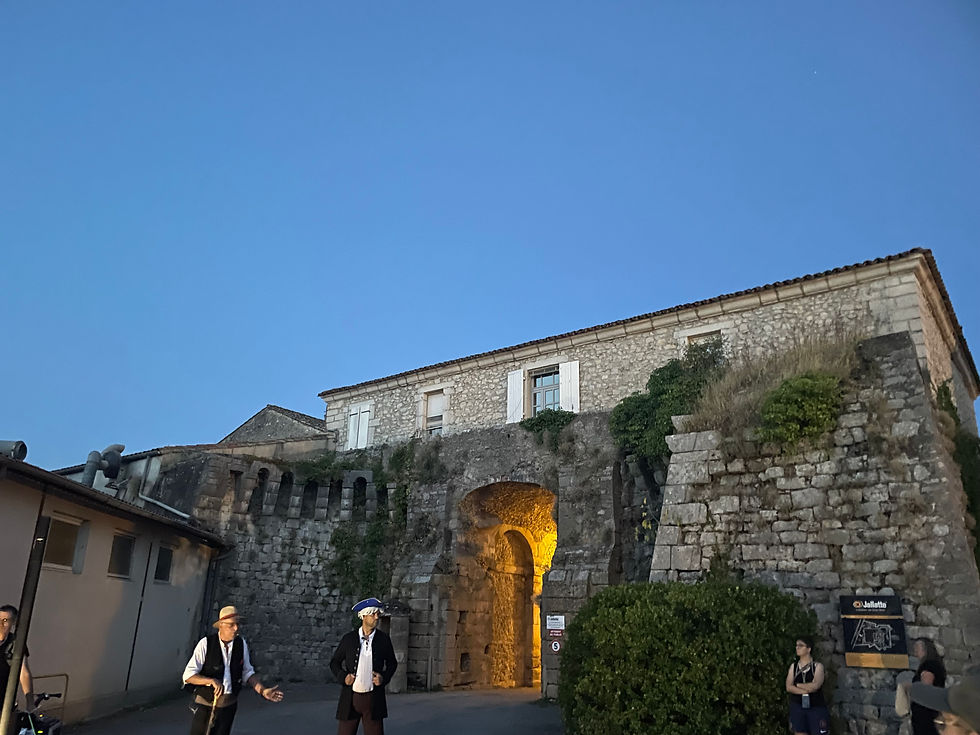A Desert Assembly
- JanetJoanouWeiner

- Sep 18, 2021
- 4 min read
Updated: Sep 23, 2021
For over 100 years, on the first Sunday of September, a massive gathering of descendants of the Huguenots (French Protestants) takes place about 40 minutes from my home. Despite the proximity, and living here for over a decade, this is the first year I made it to the service. Finally!

My friend and colleague, here on the left is a descendant of the Huguenots
This outdoor event is the Assemblée du Désert or Desert Assembly, a name that needs some explanation. In French Protestant history, "Desert" defines a period that began with King Louis XIV outlawing their existence in 1685 and ended with freedoms insured after the French Revolution in 1789.
With the stroke of a pen, King Louis decreed Protestantism illegal, forcing the Huguenots to convert to his "one true religion" or flee the country. Over 300,000 then left in a mass exodus now called the "Refuge." The Huguenots had two weeks to get out of France before the borders closed.
These displaced Huguenots traveled through France, harassed by the king's soldiers, finally escaping to safety in Switzerland, Germany, Holland, England, South Africa, and America. Their skills blessed the nations that took them in: clock-making in Switzerland and banking in England, for example. This was a significant mistake by King Louis, this "brain drain" of professionals and artisans known for their incredible work ethic.

Many of the Huguenots who stayed in France converted to Catholicism under tremendous pressure, including violence and financial bribes. Others refused, and went underground, meeting in the middle of the night for worship in isolated places. I live in the Cévennes, where the forests, mountains, and caves provided excellent cover for the hidden meetings of the "Church of the Desert."

The word "desert" also had a biblical meaning for the persecuted Huguenots. They saw a correlation between their trials and the forty years the Israelites of the exodus wandered in the desert. Both groups faced trials, persecution, and battles. Yet the desert was also a place where God led them and miraculously provided for their needs.
I've visited several of the caves used by the clandestine church. Today we can drive and then only take a short walk or hike to get there. But that was not true back in the day. The Huguenots often walked for hours for the needed encouragement of gathering with fellow believers, to worship and hear teaching from the Bible.
I've stood in the damp dark and worshipped with my friends, while imagining hundreds of Huguenots gathered there at extreme risk. I'm grateful to have this tiny glimpse of their courageous lives.
Sometimes a fellow villager notified the king's authorities of these illegal gatherings for a monetary reward. The consequences to the Huguenots were severe. The pastors were publicly tortured and beaten to death on a cruel device called the "wheel." Children were taken from their parents and sent to convents to be "re-educated" (at the expense of the family!)

From the Musée du Désert; the names listed are of pastors who died for their faith

Authorities sent the men arrested in a forbidden "desert" service to row in galley ships in the Marseille harbor, chained there until death, which usually occurred in under two years.

Model of galley ship in the Musée du Désert

The women caught in attendance at a clandestine service were sent to one of the various prisons around the country. One of the most well-known is about an hour from where I live, the Tour Constance in Aïgues-Mortes. One Huguenot prisoner, Marie Durand, was incarcerated there for 38 years and famously scratched "résister" (Resist!) into the stone floor of her cell. A simple statement of "I join you," to the Catholic authorities and she would have gone free. But, she, with many other Huguenot men and women, resisted. Many died for their faith.
Two hundred and fifty some years later, during World War II, the nascent Resistance movement in France drew their name and inspiration from Marie Durand's life and message.



Much of this little-known history (even in France!) can be found in the Musée du Désert in Mialet. Bibles, king's edicts, and many artifacts are on display in the former home of the Huguenot's leader in their Camisard war against the king. For several years in the early 18th century, a tenacious group of Huguenot men–and women–fought and held off the king's soldiers far beyond what anyone would have expected.

The September gathering occurs every year on the grounds around the Musée du Désert, usually drawing 10,000-20,000 people! This year, the numbers were lower due to ongoing covid concerns, but it was still an impressive crowd. People, primarily Huguenot descendants, attend from all over France plus Belgium, Germany, and Holland.

The Huguenot story in France is full of painful, violent, repressive incidents. But more than that, it is full of people of great faith in God and their perseverance and willingness to die for what they believed.
I am truly blessed and inspired to live among them.
La vie est belle.








Typo - 'Not surprising : )
Thank you for this post - so much fascinating information about Huguenot history that I hadn't heard. As I've Huguenot ancestry, I would so love to have been at that Desert gathering and also visit the Musée du Désert one day. Last month I visited the cemetery in Loudun ( near Chinon and Saumur) to see if I could find my relative ( Jean Turmeau) but no joy. It was of course mostly catholic and there wasn't a Protestant one that I could find ( surprising given the history)!